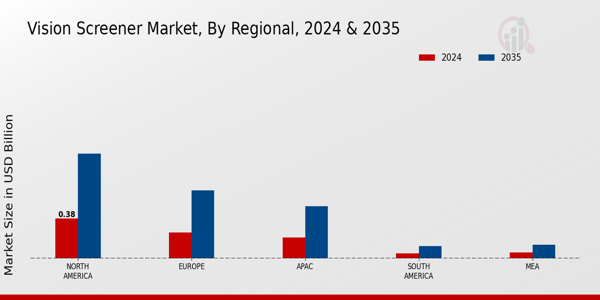Government Initiatives and Funding
Government initiatives aimed at improving eye health are playing a crucial role in the Vision Screener Market. Various countries have launched programs to promote regular vision screenings, particularly among children and the elderly. For instance, funding for vision health initiatives has increased, with some governments allocating millions to enhance screening infrastructure. These efforts are likely to lead to a rise in the adoption of vision screening devices in public health settings. As a result, the Vision Screener Market is anticipated to benefit from increased investments and support from governmental bodies, fostering a more robust framework for vision care.
Rising Prevalence of Vision Disorders
The increasing incidence of vision disorders among various age groups appears to be a primary driver for the Vision Screener Market. According to recent statistics, approximately 2.7 billion individuals are affected by some form of visual impairment. This alarming trend necessitates the implementation of effective screening solutions, thereby propelling the demand for vision screeners. As awareness of the importance of early detection grows, healthcare providers are likely to invest more in advanced screening technologies. The Vision Screener Market is thus positioned to expand significantly, as stakeholders recognize the need for timely interventions to mitigate the impact of vision-related issues.
Integration of Artificial Intelligence
The integration of artificial intelligence (AI) into vision screening technologies is transforming the Vision Screener Market. AI algorithms enhance the accuracy and efficiency of screenings, allowing for quicker diagnoses and improved patient outcomes. Recent advancements indicate that AI can reduce the time required for screening by up to 50%, which is particularly beneficial in high-demand settings such as schools and clinics. This technological evolution not only streamlines the screening process but also increases the accessibility of vision care. As healthcare systems continue to adopt AI-driven solutions, the Vision Screener Market is expected to witness substantial growth, driven by the demand for innovative and effective screening methods.
Growing Demand for Telehealth Solutions
The surge in telehealth services is influencing the Vision Screener Market significantly. As healthcare providers adapt to remote care models, the need for portable and user-friendly vision screening devices has become apparent. Telehealth platforms are increasingly incorporating vision screening tools, allowing patients to receive assessments from the comfort of their homes. This trend is particularly relevant in rural and underserved areas, where access to traditional eye care may be limited. Consequently, the Vision Screener Market is likely to experience growth as manufacturers develop innovative solutions that cater to the evolving needs of telehealth.
Increased Focus on Pediatric Vision Health
The heightened focus on pediatric vision health is emerging as a vital driver for the Vision Screener Market. With studies indicating that 1 in 4 children has a vision problem, early detection is essential for effective treatment. Schools and pediatric healthcare providers are increasingly prioritizing vision screenings to identify issues at a young age. This trend is supported by initiatives that encourage regular eye exams for children, leading to a greater demand for efficient screening tools. As awareness of the importance of pediatric vision health continues to rise, the Vision Screener Market is expected to expand, driven by the need for specialized screening solutions.











Leave a Comment